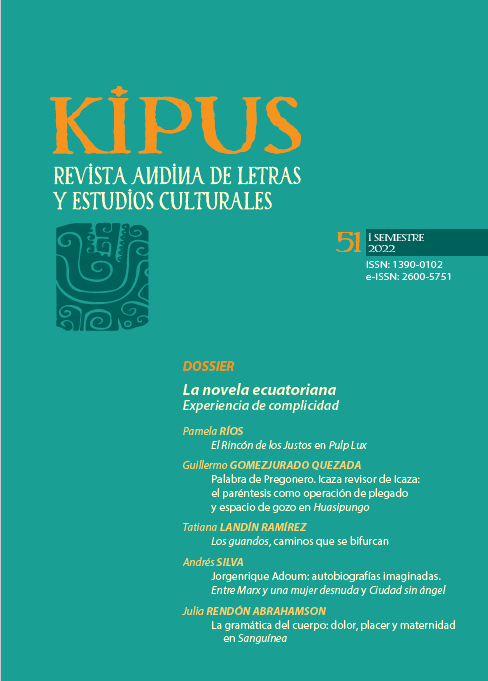El Rincón de los Justos in Pulp Lux
DOI:
https://doi.org/10.32719/13900102.2022.51.2Keywords:
Ecuador, novel, comic, Matavilela, folletín, magazine, culture, high, low, time, afterpopAbstract
El Rincón de los Justos (1983) by Jorge Velasco Mackenzie, a writer from Guayaquil, permeates the frontiers of high culture and popular culture. This hybridity responds to several economic, political and aesthetic factors of modernity. The novel offers us a radical rupture of the frontiers between elite and pop, the serious and the festive, the canon and the margin. It also invites us to think of a critique beyond heroes and grand narratives, accounting for the rise of the domestic and the quotidian. This desacralization of what has been done in national literature merits recategorizing some concepts. Eloy Fernández Porta calls the literature of the new millennium afterpop and in his book Homo Sampler he attributes this new way of conceiving time to the temporal loop. Velasco Mackenzie’s novel is ahead of its time. The other city, the other language, counter-writing, the change of perspectives and, above all, the transformation of the fragment to make comics, the folletín or serialized magazines, the structural basis that makes El Rincón de los Justos one of the most important novels of Ecuadorian literature.
Downloads
References
Fernández Porta, Eloy. 2007. Afterpop. Barcelona: Anagrama.
–––. 2008. Homo Sampler. Barcelona: Anagrama.
Molina, Yanko, y Valeria Molina. 2014. El Santo vive en Matavilela. Quito: La Caracola.
Velasco Mackenzie, Jorge. 2007. El Rincón de los ustos. Guayaquil: Publicaciones de la Biblioteca de la Ilustre Municipalidad de Guayaquil.
Williams, Robert. 2000. The Lowbrow art of Robert Williams. San Francisco: Last Gasp.
Downloads
Published
How to Cite
Issue
Section
License

This work is licensed under a Creative Commons Attribution-NonCommercial-ShareAlike 4.0 International License.








.png)
